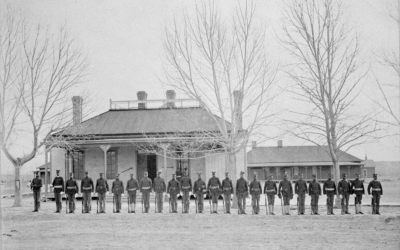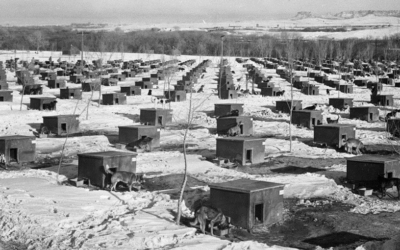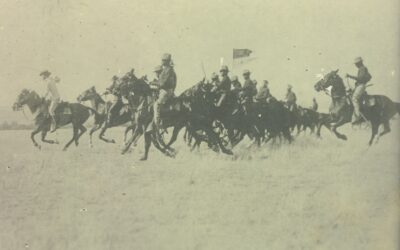Fort Robinson History Center
Fort Robinson Timeline
1868 - 1875
1868 — Treaty guarantees Sioux and other tribes food and supplies for land ceded to the U.S. Red Cloud Indian Agency established on Platte River in Wyoming, just west of the Nebraska line, to distribute goods to tribes.
1873 — Red Cloud Agency moved to a new site on the White River in northwest Nebraska.
February 9, 1874 — Acting agent Frank Appleton killed by warrior at Red Cloud Agency; Lt. Levi Robinson ambushed and killed while on wood train escort from Fort Laramie by Indians from Red Cloud Agency.
March 2-7, 1874 — The 949-man Sioux Expedition leaves Fort Laramie to protect the Red Cloud Indian Agency. Tent camp established near agency, named Camp Red Cloud Agency.
March 29, 1874 — Tent camp renamed Camp Robinson after Lieutenant Levi Robinson, killed the previous month. Captain Arthur MacArthur becomes the first post commander.
May 1874 — Camp Robinson moved a mile.
June 1874 — New post commander Captain William Jordan arrives and issues orders for construction of the first permanent barracks.
1876 - 1885
February 1876 — American flag raised for the first time over Camp Robinson.
July 17, 1876 — Battle of Warbonnet Creek. Troops from Fort Laramie under the command of Colonel Wesley Merritt intercept and turn back Native Americans fleeing Red Cloud Agency to join Crazy Horse after the Little Big Horn battle.
October 23, 1876 — General George Crook leads his Big Horn and Yellowstone Expedition troops into Camp Robinson and disbands the expedition.
May 6, 1877 — Famed Sioux warrior Crazy Horse surrenders his band of 889 at Camp Robinson.
September 5, 1877 — Crazy Horse killed while trying to escape imprisonment at Camp Robinson.
October 25, 1877 — Red Cloud Agency moved to new site on the Missouri River, later relocated to present site of Pine Ridge Agency in South Dakota.
October 1878 — A band of 149 Cheyenne led by Chief Dull Knife captured by troops from Camp Robinson and taken into custody at the post. The Cheyenne had escaped from Oklahoma (then Indian Territory) a month earlier and were on their way to their northern homeland.
December 1878 — Camp Robinson renamed Fort Robinson.
January 9, 1879 — The Cheyenne Breakout begins when Dull Knife’s people escape from barracks at the fort.
January 22, 1879 — Last of escaping Cheyenne killed or captured, ending what is commonly known as the Fort Robinson massacre.
1886 - 1900
1886 — Fremont, Elkhorn, and Missouri Valley Railroad reach Fort Robinson.
1887 — Fort Robinson expands, becoming a cavalry regimental headquarters post.
November 19, 1890 — The Ninth Cavalry, under Major Guy V. Henry, leaves Fort Robinson for the Pine Ridge Agency in case the Sioux go to war as a result of their Ghost Dance ceremonies.
December 29, 1890 — Wounded Knee Massacre.
1897 — High-wheel Columbia bicycles tested at Fort Robinson for field use.
1901 – 1940
1906 — Tenth Cavalry from Fort Robinson intercepts 300 Ute Indians fleeing their reservation and escorts them to Fort Meade, South Dakota.
1919 — Quartermaster Remount Depot established at Fort Robinson. It developed over the years into the world’s largest training, care, and breeding center for army horses and mules.
1928-31 — Fourth Field Artillery stationed at Fort Robinson.
1935-39 — U.S. Olympic Equestrian team trains at Fort Robinson.
1941 - 1980
October 3, 1942 — War Dog Reception and Training Center established.
March 15, 1943 — German prisoner-or-war camp established.
1946 — War Dog Reception and Training Center and German POW camps close.
1948 — Fort Robinson declared surplus and turned over to the U.S. Department of Agriculture.
April 29, 1949 — USDA Beef Cattle Research Station opened.
1954-64 — Soil Conservation Service Training Center (USDA) at Fort Robinson.
1955 — First parcel for Fort Robinson State Park acquired by Game and Parks Commission.
June 3, 1956 — Fort Robinson Museum opened by Nebraska State Historical Society.
1971 — USDA Beef Cattle Research Station closes.
1972 — James Ranch acquisition increased Fort Robinson State Park over 22,000 acres.
Become a Member!
Our members make history happen.






